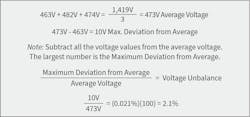Understanding Voltage Unbalance Measurements and Calculations
A farmer is watering an alfalfa field 24 hours a day using a 3-phase 100-hp electric motor and adjustable speed drive (ASD). The farmer checks on his field to find the water not flowing and the pump stopped. Further investigation reveals that the ASD tripped on “VUmb” or voltage unbalance. The ASD is reset and runs another 12 hours before shutting down again on “VUmb.” By the time the electrician is able to troubleshoot the problem, the motor is running again. What is voltage unbalance and why does the ASD shutdown? Let’s look into the theory and calculations to check the actual voltage unbalance.
Voltage unbalance is simply a variation in the phase-to-phase voltage in 3-phase electrical systems. For example, in a 480V nominal system, you may measure phase-to-phase voltage: 463V, 482V, and 474V. It is important to note that voltage unbalance will generate a current unbalance or magnify any existing current unbalance. The National Electrical Manufacturers Association (NEMA) MG1-2016 (Motors & Generators) standard specifies that for every 1% of voltage unbalance, 6% to 10% of current unbalance will be generated.
American National Standards Institute (ANSI) C84.1-2016 suggests that the electric utility system not exceed a 3% voltage unbalance. Many electric utilities have set limits at 2.5% to 3%; however, there is no standard published that mandates this value. Voltage unbalance can be caused by various problems in the electric utility system and in a facility. Generally, improperly balanced load on electrical distribution circuits, long electrical distribution radial circuits, a blown capacitor bank fuse, and improperly transposed transmission circuits will contribute to voltage unbalance. In a facility, voltage unbalance can be generated from improperly balanced panelboards and switchgear and poorly wound electric motors.
To calculate voltage unbalance the most common formula used is the “maximum deviation from average.” An example of the formula is shown below.
When taking phase-to-phase voltage measurements, the downstream load must be turned off; if possible, open the main breaker. First, calculate the average voltage. Second, subtract the average voltage and each phase measurement to find the greatest difference. This value is the maximum deviation from average. Finally, divide the average voltage and maximum deviation to calculate the voltage unbalance. If you identify that the voltage unbalance is close to or greater than 3%, then contact the electric utility to troubleshoot the problem.
About the Author
Bryan Glenn
Power Quality Consultant
Bryan Glenn is a power quality consultant for EC&M magazine. He can be reached at [email protected].

